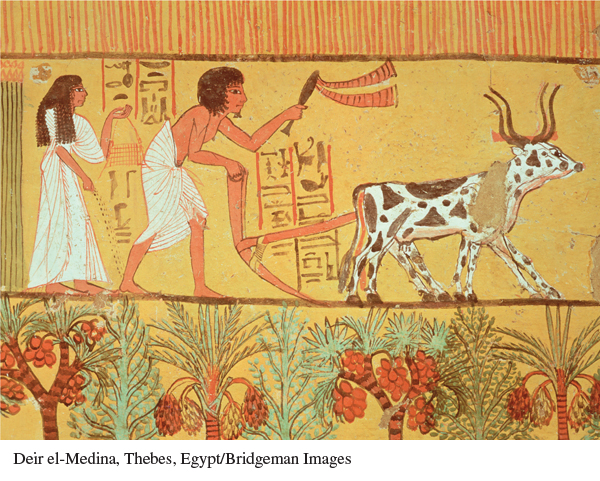A History of Western Society: Printed Page 2
A History of Western Society, Value Edition: Printed Page 1
A History of Western Society, Concise Edition: Printed Page 3
Introduction for Chapter 1
1
Origins
TO 1200 B.C.E.
What is history? That seemingly simple question hides great complexities. If history is the story of humans, what does it mean to be human? As they have in the past, philosophers, religious leaders, politicians, physicians, and others wrestle with this question every day, as do scientists using technologies that were unavailable until very recently, such as DNA analysis and radiocarbon dating. Is all of the human past “history”? Previous generations of historians would generally have answered no, that history only began when writing began and everything before that was “prehistory.” This leaves out most of the human story, however, and today historians no longer see writing as such a sharp dividing line. They explore all eras of the human past using many different types of sources, although they do still tend to pay more attention to written sources.
For most of their history, humans were foragers moving through the landscape, inventing ever more specialized tools. About 11,000 years ago, people in some places domesticated plants and animals, which many scholars describe as the most significant change in human history. They began to live in permanent villages, some of which grew into cities. They created structures of governance to control their more complex societies, along with military forces and taxation systems. Some invented writing to record taxes, inventories, and payments, and they later put writing to other uses, including the preservation of stories, traditions, and history. The first places where these new technologies and systems were introduced were the Tigris and Euphrates River Valleys of southwest Asia and the Nile Valley of northeast Africa, areas whose history became linked through trade connections, military conquests, and migrations.▪

CHAPTER PREVIEW
What do we mean by “the West” and “Western civilization”?
How did early human societies develop and create new technologies and cultural forms?
What kind of civilization did the Sumerians develop in Mesopotamia?
How did the Akkadian and Old Babylonian empires develop in Mesopotamia?
How did the Egyptians create a prosperous and long-
Chronology
| ca. 250,000 B.C.E. | Homo sapiens evolve in Africa |
| 250,000–9000 B.C.E. | Paleolithic era |
| 9000 B.C.E. | Beginning of the Neolithic; crop raising; domestication of sheep and goats |
| ca. 7000 B.C.E. | Domestication of cattle; plow agriculture |
| ca. 5500 B.C.E. | Smelting of copper |
| ca. 3800 B.C.E. | Establishment of first Mesopotamian cities |
| ca. 3200 B.C.E. | Development of cuneiform and hieroglyphic writing |
| ca. 3100 B.C.E. | Unification of Upper and Lower Egypt |
| ca. 3000 B.C.E. | Development of wheeled transport; beginning of bronze technology |
| ca. 2500 B.C.E. | Bronze technology becomes common in many areas |
| ca. 2300 B.C.E. | Establishment of the Akkadian empire |
| ca. 1800 B.C.E. | Hyksos people begin to settle in the Nile Delta |
| 1792–1750 B.C.E. | Hammurabi rules Babylon |
| 1258 B.C.E. | Peace treaty between Egyptian pharaoh Ramesses II and Hittite king Hattusili III |
| ca. 1200 B.C.E. | “Bronze Age Collapse”; destruction and drought |
A note on dates:This book generally uses the terms B.C.E.(Before the Common Era) and C.E.(Common Era) when giving dates, a system of chronology based on the Christian calendar and now used widely around the world.